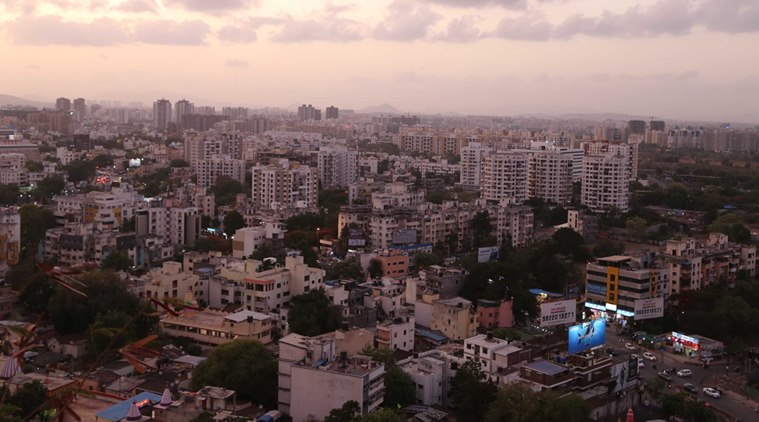 The GOI official also pointed out that the “own revenues” of Urban Local Bodies in India, as a per cent of GDP, is less than one per cent. (Express archives)
The GOI official also pointed out that the “own revenues” of Urban Local Bodies in India, as a per cent of GDP, is less than one per cent. (Express archives)
Urban development schemes like Smart City Mission, Amrut Mission and Swacch Bharat are moving at a slow place in various cities of India that are facing “large infrastructure deficit” and “poor quality of urban services,” said Dr Kumar V Pratap, Joint Secretary (Infrastructure, Policy and Finance), Ministry of Finance, Government of India, while speaking at an event in Ahmedabad on Thursday.
“One third of India that lives in urban areas contributes two-third of the GDP. If India needs to retain it’s position as the fastest growing large economy in the world, then the contribution of the urban areas have to increase. Giving the condition of our urban areas, status quo would mean, it will become the binding constraint of our Indian economy,” said Pratap, while addressing a two-day seminar on urban development organised by the Union finance ministry and Research and Information System for Developing Countries (RIS).
Read |
The official pointed out that 10-12 million people are being added every year to the urban population of India and it is expected that by the year 2030, 40 per cent of India’s population or 600 million people will be living in urban areas that contribute 75 per cent to the national GDP. “Urban India has a large infrastructure deficit and this is manifested in poor quality of urban services to the population. The challenge is to provide minimum urban services to the rapidly growing urban population in India, while the present population is being underserved,” he added.
Talking about the various urban development schemes launched by the Modi government, Pratap said, “The central government has launched the smart city mission, the Amrut mission for rejuvenation of urban transformation and the Swacch Bharat mission as part of the holistic strategy of urban development. However, work in these missions is moving at a slow pace. It has been reported that only about two per cent of the Rs 9943 crore released for the Smart City mission have been utilised so far. Similarly, 24 water supply projects worth only about Rs nine crore have been completed so far under Amrut, while 494 contracts worth Rs 19000 crore awarded.”
The GOI official also pointed out that the “own revenues” of Urban Local Bodies in India, as a per cent of GDP, is less than one per cent. “While property taxes are the most important constituent of own revenues, there are problems of low coverage, low rates, low collection efficiency and lack of indexation of property values,” he added pointing out that the 13th finance commission had estimated that only about 21 per cent of the property taxes are collected. Similarly, the economic survey 2016-17 also stated that cities of Bengaluru and Jaipur were collecting only 5-20 per cent of the property tax collection potential.
Property tax collections in municipal corporations in Gujarat over 90 per cent
However, an official from the Gujarat government who participated in the inaugural session pointed out that the property tax recovery in eight municipal corporations were over 90 per cent, while it was at an unimpressive 50 per cent in 162 municipalities of the state. “The larger corporations — we have eight of those; Ahmedabad, Surat, Vadodara, Rajkot, Bhavnagar, Junagadh, Jamnagar and Gandhinagar — are well administered. They have their internal resources also. To cite one figure, the property tax collection in the corporations last financial year is more than 90 per cent. So recovery is not difficult. We have 162 municipalities with a population as high as one lakh. The average property tax collection is just above 50 per cent. Somehow the smaller municipalities just do not have the capacity to collect their resources,” said Mukesh Puri, Principal Secretary, Urban development and urban housing department, Government of Gujarat.
Puri pointed out that Ahmedabad has a property tax collections efficiency of 97 per cent. “Just outside the city, the prosperous areas of Bopal and Sanand see the numbers drop by at least 30 per cent. As you go further into the hinterland it comes to 40-45 per cent. Clearly, it is the capacity of the system to recover the dues. It is not that the people are unwilling to pay,” the IAS officer added.
“The smaller corporations are finding it very difficult to absorb the funds which are coming from the Government of India, finance commission and various other sources. Many of these funds are coming directly. However, the capacity is missing in terms of the technical expertise for making DPRs, hiring consultants, doing the tender process in a transparent manner. Those gaps are there,” Puri said adding that quality of life in smaller cities in Gujarat “were in dire straits.”
He said in order to correct this the state government has recently appointed regional municipal commissioners who will on an average overseeing and monitoring 30 municipalities. “The institution has just been set up. Six officers have just been posted. Now we will empower them and delegate powers.” These officers have been appointed at Ahmedabad, Surat, Vadodara, Gandhinagar, Rajkot and Bhavnagar.
Talking about the internal resources by urban local bodies in the state, the Gujarat government official also pointed out that the Ahmedabad Urban Development Authority (AUDA) has a corpus of more than Rs 1000 crore and it is spending more than Rs 250 crore on building six bridges and underbridges on the ring road. “